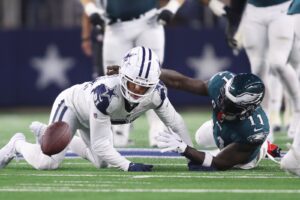Josh Jacobs had a solid rookie season, but how will he and the other top 2019 rookie running backs fare in year two. With the 2020 NFL Draft fast approaching, now’s a great time to review last year’s rookie running back class and project their outlook for year two.
Fantasy Football: Josh Jacobs and Other Sophomore Running Backs 2019 Review, 2020 Preview
Josh Jacobs 2019 Review
Josh Jacobs burst on the scene in his first start of the year. In Week 1 of the 2019 season, he saw 23 carries and scored two touchdowns. However, over Jacobs’ next three games, he ran well but saw less than 17 carries in each of those outings.
After Week 4, the Oakland Raiders removed the metaphorical training wheels, and Jacobs was given 20+ carries in three of the next four games. He responded with three 100+ yard outings in those games. Furthermore, Jacobs had five 100+ yard games over his next eight.
Jacobs finished his rookie season with 242 carries, 1,150 rushing yards (4.8 yards per carry), and seven rushing touchdowns. He added 20 receptions for 166 yards. Overall, Jacobs put up great numbers, especially considering he played in only 13 games. Jacobs missed Weeks 14, 16, and 17 with a shoulder injury. So it would appear there is still more meat on the bone if Jacobs plays in all 16 games next season.
Raiders RB Josh Jacobs led NFL in broken tackles in 2019 https://t.co/ylLpIKqUPx
— Raiders Wire (@TheRaidersWire) January 23, 2020
Josh Jacobs 2020 Preview
Looking forward to 2020, Josh Jacobs has a positive outlook. The Raiders offensive line is the team’s greatest strength, yet the passing game is a weakness. The team might draft a quarterback or look for an answer in free agency. However, Jacobs is the Raiders bellcow and should remain a focal point of the offense. That said, better play from the quarterback position might help Jacobs improve on his receiving stats, where he left more to be desired in 2019. He needs to improve significantly in that area of his game before we can consider him a top-tier fantasy running back. For now, Jacobs is safely in the RB2 conversation for 2020 fantasy drafts.
Depending on how the team is built around him and how they look in pre-season, Jacobs could move up or down in 2020 fantasy drafts. However, he will likely be the highest-ranked second year running back going into the 2020 season. Jacobs didn’t share carries his rookie season, or need a bunch of injuries to become the lead back for his team. He is firmly entrenched as the Raiders bell-cow.
Jacobs’ vision as a runner (eighth overall in evaded tackles with 6.2 per game in 2019) and secure role as the Raiders’ workhorse back are what make him an attractive option for fantasy football. He handles a sizeable workload, including goal-line carries, as the Raiders featured back. The only knock on Jacobs is his lack of involvement in the passing game. This gives him slightly less appeal in full point per reception leagues. However, he still falls into the RB2 tier in PPR, just a few spots lower on the list. In non-PPR leagues, Josh Jacobs is a borderline RB1.
Miles Sanders 2019 Review
Miles Sanders’ rookie season with the Philadelphia Eagles got off to a slow start. He began the 2019 season operating alongside Jordan Howard, Darren Sproles, and Corey Clement as part of a dreadful running-back-by-committee backfield under head coach Doug Pederson. Pederson has made RBBC work for the Eagles in past seasons, but it has been a nightmare for fantasy football purposes.
After a slew of injuries to key members of the Eagles running back committee, Sanders was able to operate in more of a featured back role the back-half of the season. He did not disappoint. Sanders had huge fantasy performances in Weeks 13, 15, and 16. He scored 21, 31, and 25 PPR points, respectively.
Sanders’ draft stock and late-season performances should indicate an uptick in usage for Sanders in 2020. However, recent history suggests that the Eagles might return to an RBBC approach. Who the Eagles bring in or don’t bring in at running back this off-season will be the most telling for how the team intends to use Sanders in 2020.
Sanders finished his rookie season with 179 carries, 818 yards (4.6 yards per carry), and three touchdowns. He also caught 50 out of 63 passes for 509 yards and three receiving touchdowns. Sanders finished seventh in the league amongst running backs in 2019 with a 5.8 yards per touch average. He will aim to improve those numbers in 2020.
.@BoobieMilesXXIV balled out in his rookie season:
1,641 all-purpose yards
4.6 yards per carry
10.2 yards per catch#FlyEaglesFly pic.twitter.com/ilvB8QZFHx— Philadelphia Eagles (@Eagles) January 7, 2020
Miles Sanders 2020 Preview
Currently, the only running backs under contract with Philadelphia are Sanders and Boston Scott. Scott isn’t a big threat to Sanders’ workload, but the Eagles might sign or draft someone to work in tandem with Sanders next season. Sanders’ explosive capabilities as both a pass-catcher and runner make him a desirable option for fantasy football, and even more so in PPR fantasy formats.
Of the top four sophomore running backs, Sanders might have the highest ceiling. He is a multidimensional player and a tremendous athlete, ranking in the 76th percentile in SPARQ score. However, he is also the most volatile of the group, due to the historical RBBC usage in Philly under Pederson. If Sanders goes into 2020 as the unchallenged starter for the Eagles, he would have tremendous upside. How the Eagles choose to fill out their roster will have a big impact on Sanders 2020 fantasy outlook.
As we sit here today, Sanders has a bright outlook. He should be primed to get close to 20 touches per game in 2020. As long as the Eagles only bring in complementary pieces and not someone to work in tandem as a 1A to Sanders, he should be a solid fantasy RB2. If you can get him in round three of a 12-team redraft, you will have done well for yourself. In most cases, he’s going to be drafted late round two.
David Montgomery 2019 Review
David Montgomery might have been the biggest disappointment of the 2019 running back class. He was highly touted going into his rookie season. Though Montgomery played in all 16 games for the Chicago Bears in 2019, he was unable to showcase his skill set behind the Bears porous offensive line. Montgomery finished his rookie season with 242 carries, 889 rushing yards, and six touchdowns (3.7 yards per carry). He also caught 25 of 35 passing targets for 185 yards and one touchdown.
Montgomery was a serviceable, yet unspectacular fantasy RB3 last season. Without the threat of a passing game, defenses loaded the box to stop the run. Montgomery proved unable to create much yardage on his own. Unfortunately, the presence of Tarik Cohen also hurt Montgomery’s fantasy value. Montgomery is a capable third-down back. However, the Bears chose to stick with Cohen in obvious passing situations.
Scrimmage Yards/Game in 2019 among Rookies:
1. Josh Jacobs (101.2 avg.)
2. Miles Sanders (82.9 avg.)
3. Devin Singletary (80.8 avg.)
4. A.J. Brown (69.4 avg.)
5. David Montgomery (67.1 avg.)#JacobsForOROY pic.twitter.com/oZF9SYMmwl— Raiders PR (@RAIDERS_PR) January 9, 2020
David Montgomery 2020 Preview
Montgomery isn’t good enough to create yards on his own, and if Cohen remains on the roster, he’ll likely continue to give way to Cohen on passing downs. That said, the Bears must address their offensive line woes in the draft and free agency this off-season.
Montgomery did flash at times in 2019. In the right offense, he could be a very good fantasy option. He’s proven to be durable so far and he has the ability to operate on three downs. How the Bears offense is built in the off-season will have a big impact on Montgomery’s 2020 fantasy value. Currently, he projects as an RB3 for next season. The Bears offense would have to make drastic improvements this off-season, or Cohen would need to somehow be removed from the equation, for Montgomery to move into the RB2 conversation.
It’s an important off-season for Montgomery. His future in the NFL might be significantly impacted by who the Bears bring on board to help the team compete in 2020. Will it be enough to help Montgomery shine? Or will he falter once again and prove to be just another interchangeable piece at running back? Unfortunately, until the quarterback woes are fixed in Chicago, it’s likely going to be tough sledding for Montgomery. Being only a 15th percentile SPARQ athlete doesn’t bode well for Montgomery, who is likely operating at his peak athletic level. If he doesn’t get help around him soon, he could end up falling by the wayside. As things stand today, Montgomery is shaping up to be a late round five pick in 12-team redrafts leagues.
Devin Singletary 2019 Review
Devin Singletary began his rookie season with the Buffalo Bills working behind veteran running back Frank Gore. Singletary finished his 2019 season with 775 rushing yards, two touchdowns on 151 carries (5.1 yards per carry), and 29 receptions, 194 yards, and two receiving touchdowns.
Most of Singletary’s production came in the second half of the season. He racked up 603 rushing yards over his final eight games. Proof that Singletary should take a big leap in year two.
If Gore is released or retires during the off-season, Singletary could be called upon to serve as a three-down workhorse. However, even if Gore returns to the Bills in 2020, it’s likely Singletary showed enough in the second half of last season to be considered the team’s feature back. After all, Singletary’s 5.1 yards per rushing attempt led all qualifying running backs in 2019.
Devin Singletary averages 16.5 rushing attempts / game since Week 9.@JeffRatcliffe:https://t.co/2DrHH0tDqV
— PFF Fantasy Football (@PFF_Fantasy) January 4, 2020
Devin Singletary 2020 Preview
Singletary is poised to take on a larger role in his sophomore season. He showcased an explosive skill set his rookie year. If he can lock down a three-down role with the Bills in 2020, the sky is the limit for Singletary.
One knock against Singletary is his durability. He missed three games his rookie year with a hamstring issue. The major concern with Singletary is if he’s asked to carry the load next season, can he hold up through 16 games? However, with a strong defense, strong O-line, and a rushing threat at quarterback, the Bills are built to run the rock. When Singletary is in the game, he’s fully capable of taking advantage of the opportunity. Singletary is likely going to be a popular breakout candidate in 2020, and for a good reason. His numbers should increase across the board now that he will begin the 2020 season as the Bills starting tailback.
One word of warning against over-drafting Singletary. Although he proved capable of taking advantage of great run blocking in 2019, he is only a 12th percentile SPARQ athlete. He is also slightly undersized at 5’7” tall and approximately 203 pounds. If the O-line in Buffalo takes a step back, Singletary could see a significant decline in per touch average. Look for Singletary to be drafted shortly after Jacobs and Sanders come off the board. As things stand right now, Singletary should be drafted late third or early fourth round in 12-team leagues.
[Stats and metrics via Player Profiler]






